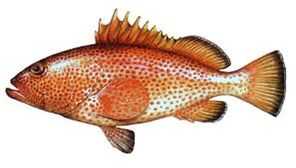Red Hind

Species Details
Epinephelus Guttatus
Serranidae
Perciformes
Nearshore, Offshore, Reef
3 - 49 lbs.
12" - 30"
Red Hind (Epinephelus guttatus) Fish Description
The Red Hind fish, also known under the names of the Red Hind Grouper, Rock Cod, Koon, Cod, Deady, Hind, Lucky Grouper, and Trout.
They have a stout, plump body with colors varying from pink to reddish to greenish-grey. They have a large mouth with soft dorsal, anal, and caudal fins. Red Hind fish are covered in dark red spots all around their head, body, and fins, while their underparts are typically paler.
To distinguish them from the Rock Hind, a close relative of theirs, the Red Hind has no dark blots on its tail nor the dorsal fin and instead has broad black margins.
Diet & Size
Red Hind consumes predominantly mantis shrimps, which makes up around 15% of their diet. Other things on their menu are crab and fishes, like the Bluehead wrasse, goatfishes, and small morays. But they mostly prefer shrimps and octopuses. Red Hind can grow up to the maximum length of 30 in., but on average found to be around 16 in. The maximum weight observed for the Red Hind is up to 49 lbs.
Interesting Facts about Red Hind
- Red Hinds are considered to be protogynous hermaphrodites, as they can change sexes from females to males during a stage in their life cycle.
- When spawning aggregation ensues, the Red Hinds occupying the surrounding area would travel to a certain area to meet and mate. A number of reports from Puerto Rico have claimed that some Red Hind have been tagged and noticed to have travelled more than 10 miles for such a meet.
- Red Hind, also known to be part of the Grouper family, have been estimated to be able to live up to 50 years of age!
- The days of the Red Hind are often spent either resting or swimming slowly, they are most active during dusk and dawn.
- Due to all the blots, spots, and splotches that cover their body, Red Hinds are well camouflaged.
Fishing Techniques
When game fishing for Red Hind, it could be quite a challenge but it isn’t impossible. One simple, yet effective way of rigging for a Red Hind is called a Double Dropper Loop.
Creating this loop, you’re going to want to use a pole rated between 20-50 lb range, or 15-40 lb. range, and a 25-35 lb monofilament line, and for the hooks, you’ll need 2 circle hooks in either the 2/0 or 4/0 range for the ideal results. As for sinkers, a torpedo-style or a lead weight in the 6-12oz. the range would be best for creating the Double Dropper Loop. One of the most crucial steps is to make sure to insert the loop through the pointed side of the hole on the hook. Insert it through the eye of the torpedo-shaped sinker on its bottom loop, and loop it over again the sinker.
Finally, you need to attach a bait. Baits like a strip of squid, anchovies, or sardines would be most suitable. Be sure to attach the bait at the end of the hook so it has a chance to move around with the current, because the more natural the bait would seem to the fish, the more attractive it is to get a bite from a Red Hind.
When you sense the Red Hind bites, wind it up to hook it, but don’t pump the line. Try and lift it and wind down, instead. Because by pumping it, you could risk losing the fish. So patience by using slow and steady is necessary for angling for the Red Hind.
If you don’t want to rig a line yourself, you can buy plenty of pre-made rigs specifically tailored for Red Hind fishing. One of the most ideal pre-made rigs is those with a braided line for the reel, which you’ll only need to swivel in the brain and tie the monofilament line. Braided lines are especially helpful when deep water fishing, so you can be more confident when something takes a bite of your bait!
Habitat and Distribution
Red Hind fish are commonly seen in the western Atlantic. But their range extends from Bermuda, northern Carolina, and along the eastern coast of the United States onwards into the Gulf of Mexico and the Caribbean. Others say they can also be found as far as Brazil, but there have been no confirmed records yet from the south of Venezuela.
Red hinds frequently inhabit coral reefs and rocky bottoms, the female Rock Hinds tend to stay close to the bottom, while the male Rock Hinds patrol and defend an area from other males overlapping the home ranges.






